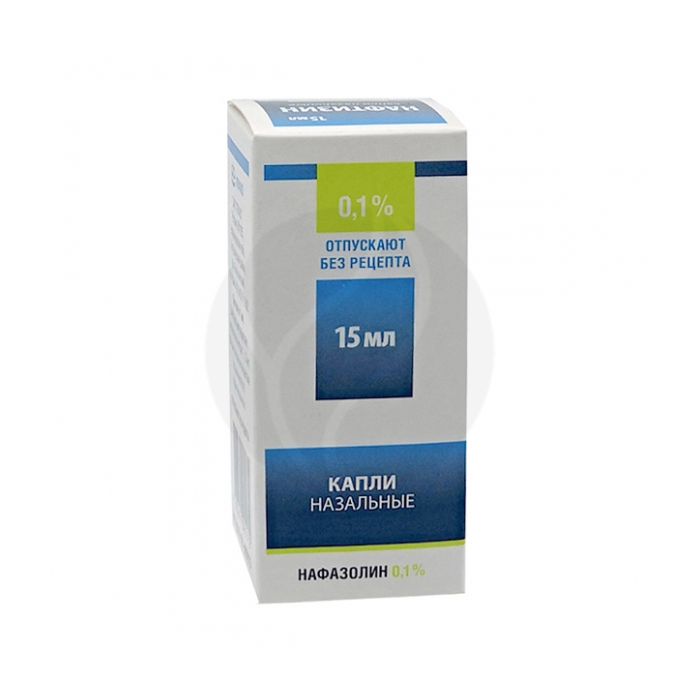Naphthyzin drops 0.1%, 15ml
Expiration Date: 05/2027
Russian Pharmacy name:
Нафтизин капли 0.1%, 15мл
Acute rhinitis (including against the background of acute respiratory diseases and allergic rhinitis), sinusitis, eustachitis, laryngitis, laryngeal edema of allergic genesis, laryngeal edema on the background of radiation, hyperemia of the mucous membrane after operations on the upper respiratory tract.
To stop nosebleeds.
Intranasally (in each nasal passage), adults and children over 15 years of age are prescribed 1-3 drops of a 0.05% - 0.1% solution 3-4 times a day.
In children over 2 years old, a 0.05% solution is used (or a 0.025% solution, diluting a 0.05% solution with distilled water): from 2 to 6 years old - 1-2 drops each, from 6 to 15 years old - 2 drops each 1- 3 times a day.
For diagnostic purposes - after cleaning the nose, drip 3-4 drops into each nasal passage or insert a tampon soaked in 0.05% solution and leave for 1-2 minutes;
in case of edema of the vocal cords, inject in small doses with a laryngeal syringe;
for bleeding - insert a tampon moistened with a 0.05% solution.
Apply for a short time, but not more than a week, not more than 3 days in children. If nasal breathing is easier. then the use of Naphthyzin can be terminated earlier. Repeated use of the drug is possible in a few days. Before the administration of the drug, the nasal passages should be thoroughly cleaned.
Composition for 1 ml:
Active ingredient: naphazoline nitrate - 0.5 mg or 1.0 mg.
Excipients: boric acid - 20.0 mg, purified water - up to 1 ml.
Hypersensitivity to naphazoline or any of the excipients,
arterial hypertension,
severe atherosclerosis,
thyrotoxicosis,
severe eye diseases, including angle-closure glaucoma,
chronic rhinitis,
atrophic rhinitis,
diabetes,
tachycardia,
simultaneous administration of monoamine oxidase inhibitors and within 14 days after the end of their use,
for a solution of 0.05% - children under 2 years of age,
for a solution of 0.1% children under 15 years of age.
Carefully
Ischemic heart disease (angina pectoris), prostatic hyperplasia, pheochromocytoma, during pregnancy and breastfeeding.
Pharmacological properties
Pharmacodynamics
Alpha-adrenostimulating agent, has a quick, pronounced and long-term vasoconstrictor effect on the vessels of the mucous membranes (reduces swelling, hyperemia, exudation). Facilitates nasal breathing with rhinitis. After 5-7 days, tolerance develops.
Pharmacokinetics
When applied topically, systemic absorption is low.
Application during pregnancy and lactation:
Application during pregnancy and during breastfeeding is possible only if the expected benefit to the mother outweighs the potential risk to the fetus or child.
Side effects
Burning or dryness of the nasal mucosa; feeling of 'stuffiness' of the nose (reactive hyperemia after the cessation of drug exposure; swelling of the mucous membrane of the nasal cavity), tachycardia. increased blood pressure. headache, irritability. nausea. allergic reactions. Prolonged and frequent use of naphazoline can lead to chronic obstruction of the nasal passages and atrophy of the nasal mucosa (rhinitis medicamentosa).
Overdose
In case of an overdose of the drug as a result of systemic effects on the body, such phenomena may develop. like nervousness. excessive sweating. headache. tremor, tachycardia, palpitations. increased blood pressure. Nausea is also a possible sign of an overdose. cyanosis, respiratory and mental disorders. In the case of depression of the central nervous system, bradycardia is observed. weakness, drowsiness, decreased body temperature, increased sweating, collapse. the development of a coma is extremely rare. Treatment: gastric lavage, intake of activated charcoal (in case of accidental ingestion of the drug): symptomatic.
Interaction with other medicinal products
Do not use concomitantly with monoamine oxidase inhibitors or within 14 days after the end of their use. Slows down the absorption of local anesthetic drugs (lengthens their effect when conducting surface anesthesia).
special instructions
May have a resorptive effect. With prolonged use, the severity of the vasoconstrictor effect gradually decreases (the phenomenon of tachyphylaxis), and therefore it is recommended to take a break for several days after 5-7 days of use. In view of the possible development of side effects from the cardiovascular and nervous systems, the dose of the drug Naftizin recommended for use should not be exceeded. Avoid getting the drug in the eyes. In order to avoid the spread of infection, it is necessary to use the drug individually.
Influence on the ability to drive vehicles, mechanisms
After prolonged use or taking remedies for the common cold, containing naphazoline in dosages exceeding the recommended ones, a general effect on the cardiovascular system and the central nervous system cannot be ruled out. In these cases, the ability to drive vehicles and moving machinery may be reduced.

